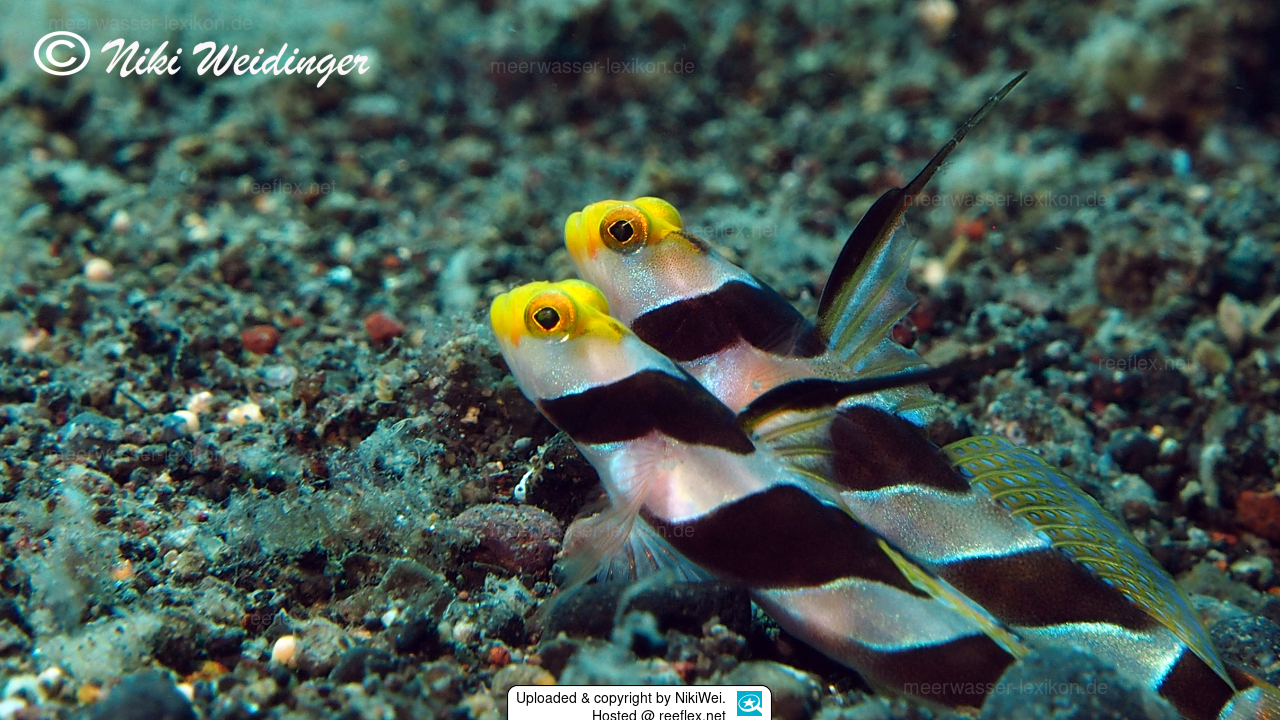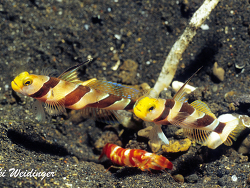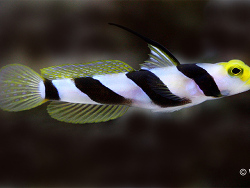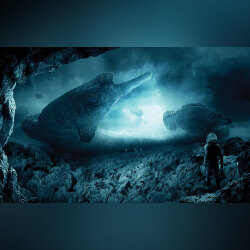Info
Stonogobiops nematodes, Hoese & Randall, 1982
The Stonogobiops gobies live in symbiosis with the crayfish species Alpheus and are very shy and skittish. However, their behavior changes if no too hectic fish are kept in the aquarium.
To acclimatize the goby, it should be accustomed to the food available in a quaternary tank. Initially, feeding should take place several times a day and can then be reduced to 2-3 times a day. Good feeding results have been achieved using an acrylic pipette (6 mm) with frozen food by placing the food in front of the cave. Stonogobiops are not very choosy when it comes to food selection. A prepared cave should be available for transferring the goby to the display tank and a PVC pipe should be placed in the direction of the cave. It is advantageous if the crayfish is the first to move into the cave.
So that the crayfish can build a suitable cave, the substrate should be at least 5-6 cm high in places and also have suitable building material available - coral rubble of at least 2-5 cm.
The aquarium should be equipped with a jump guard.
Jumping guard
A jumping guard prevents (nocturnal) fish from jumping out.
Wrasses, blennies, hawkfishs and gobies jump out of an unprotected tank in fright if their night rest is disturbed, unfortunately these jumpers are found dried up in the morning on carpets, glass edges or later behind the tank.
https://www.korallenriff.de/en/article/1925_5_Jump_Protection_Solutions_for_Fish_in_the_Aquarium__5_Net_Covers.html
A small night light also helps, as it provides the fish with a means of orientation in the dark!
Socialization / symbiosis
These gobies live together with the crayfish species Alpheus randalli. When keeping them in the aquarium, pairs should always be preferred. Furthermore, a small aquarium should be available for the shy gobies, in which no larger or hectic fish are present. Not ideal for keeping in a reef aquarium, as the shy goby will not often be seen in front of the cave and will therefore not be able to eat enough food.
There is no known visual difference between the sexes.
The gobies can be kept well together with gentle fish stocking and the keeper will be rewarded by the fact that the gobies can often be seen in front of the cave. Small, calm inhabitants are recommended for stocking - pipefishes, Elacatinus, Eviota, Trimma, Koumansetta, Synchiropus and small shrimp species.
This is not guaranteed for Ecsenius species, damselfish or wrasses of any kind and of course any larger species of fish.
We would be very grateful for any further husbandry experience regarding socialization.
Behavior
If the acclimatized goby has moved into a cave and cannot get out of it, this may be related to the tank population.
Breeding information:
Stonogobiops are cave breeders and the clutch is guarded by the male.
There are already offspring available for Stonogobiops yasha - see description there.
The water temperature influences the spawning period (with a difference of 1°C, for example, the difference can be ± 2-3 days) and, in the case of gonochoristic (separate-sex) fish or shrimps, the sex. If the temperature is below the usual regional temperature, mainly female larvae will hatch from the clutch, above this temperature mainly male larvae will hatch. Furthermore, the aquarium conditions (e.g. light duration, density) can also influence the sex.
The spawning size or the number of larvae depends on several factors - age and condition of the parents, water conditions, food, stress factors.
Danger of confusion
Stonogobiops xanthorhinicus looks the same, but has no dorsal lance fin.
It is rarely available in the trade.
The Stonogobiops gobies live in symbiosis with the crayfish species Alpheus and are very shy and skittish. However, their behavior changes if no too hectic fish are kept in the aquarium.
To acclimatize the goby, it should be accustomed to the food available in a quaternary tank. Initially, feeding should take place several times a day and can then be reduced to 2-3 times a day. Good feeding results have been achieved using an acrylic pipette (6 mm) with frozen food by placing the food in front of the cave. Stonogobiops are not very choosy when it comes to food selection. A prepared cave should be available for transferring the goby to the display tank and a PVC pipe should be placed in the direction of the cave. It is advantageous if the crayfish is the first to move into the cave.
So that the crayfish can build a suitable cave, the substrate should be at least 5-6 cm high in places and also have suitable building material available - coral rubble of at least 2-5 cm.
The aquarium should be equipped with a jump guard.
Jumping guard
A jumping guard prevents (nocturnal) fish from jumping out.
Wrasses, blennies, hawkfishs and gobies jump out of an unprotected tank in fright if their night rest is disturbed, unfortunately these jumpers are found dried up in the morning on carpets, glass edges or later behind the tank.
https://www.korallenriff.de/en/article/1925_5_Jump_Protection_Solutions_for_Fish_in_the_Aquarium__5_Net_Covers.html
A small night light also helps, as it provides the fish with a means of orientation in the dark!
Socialization / symbiosis
These gobies live together with the crayfish species Alpheus randalli. When keeping them in the aquarium, pairs should always be preferred. Furthermore, a small aquarium should be available for the shy gobies, in which no larger or hectic fish are present. Not ideal for keeping in a reef aquarium, as the shy goby will not often be seen in front of the cave and will therefore not be able to eat enough food.
There is no known visual difference between the sexes.
The gobies can be kept well together with gentle fish stocking and the keeper will be rewarded by the fact that the gobies can often be seen in front of the cave. Small, calm inhabitants are recommended for stocking - pipefishes, Elacatinus, Eviota, Trimma, Koumansetta, Synchiropus and small shrimp species.
This is not guaranteed for Ecsenius species, damselfish or wrasses of any kind and of course any larger species of fish.
We would be very grateful for any further husbandry experience regarding socialization.
Behavior
If the acclimatized goby has moved into a cave and cannot get out of it, this may be related to the tank population.
Breeding information:
Stonogobiops are cave breeders and the clutch is guarded by the male.
There are already offspring available for Stonogobiops yasha - see description there.
The water temperature influences the spawning period (with a difference of 1°C, for example, the difference can be ± 2-3 days) and, in the case of gonochoristic (separate-sex) fish or shrimps, the sex. If the temperature is below the usual regional temperature, mainly female larvae will hatch from the clutch, above this temperature mainly male larvae will hatch. Furthermore, the aquarium conditions (e.g. light duration, density) can also influence the sex.
The spawning size or the number of larvae depends on several factors - age and condition of the parents, water conditions, food, stress factors.
Danger of confusion
Stonogobiops xanthorhinicus looks the same, but has no dorsal lance fin.
It is rarely available in the trade.







 NikiWei
NikiWei



















